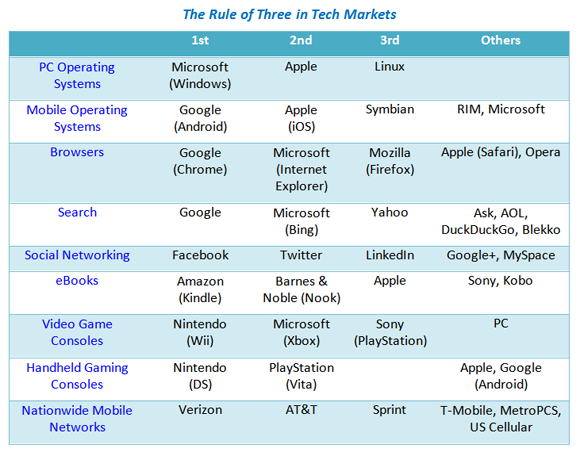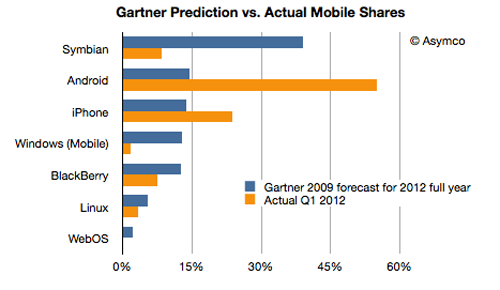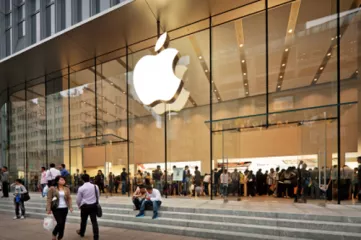- | Technology and Innovation Technology and Innovation
- | Expert Commentary Expert Commentary
- |
The Rule Of Three: The Nature of Competition In The Digital Economy
What is most important to economic progress and technological innovation is the ongoing process of constant experimentation and spontaneous discovery that allows new business models and organizational structures to emerge in response to market signals.
Can we have highly competitive and constantly-innovating markets without dozens of rivals being present? The answer is yes, and America’s high-technology marketplace proves it.
Rarely has there existed a more innovative, consumer-satisfying set of sectors than those that compromise the modern information technology (IT) marketplace. That is true despite the fact that, at any given time, most of those info-tech sectors are dominated by just a handful of major operators.
The adjoining chart isn’t scientific, but it nonetheless captures the reality that most IT sectors have three market-leading “big dogs” with a few smaller rivals nipping at their heels. In the world of business management, this is often referred to as “The Rule of Three,” and as Jagdish Sheth and Rajendra Sisodia document in their 2002 book of the same name, this phenomenon dominates not just tech markets, but many other mature sectors of the economy—from batteries to blue jean makers to burger joints.

‘Lemonade Stand Economics’ vs. Fixed Cost Realities
Why does the Rule of Three hold within so many IT sectors? Simply put, the economics of information industries are not those of the corner lemonade stand we’re all familiar with from our childhood. We’re never going to have hundreds or even dozens of companies competing to provide wireline broadband infrastructure, mobile networks, cloud storage and web services, video game consoles, or even search and social networking platforms.
There are significant fixed costs associated with providing such services. Building a sophisticated, secure, consumer-friendly digital service or networking platform takes time, resources, and a little luck. But, once you make the investment, there’s no turning back. Many fail in their effort to deliver and, after a market shakeout, a few winners emerge who somehow found the right combination that made consumers and investors happy.
Bandwagon effects are another reason we often see a Rule of Three in tech markets. Once some firms get a critical mass of users, their service can really take off and they can grab a big chunk of market share in fairly short order. This should not be mistaken with first-mover advantage, however. In fact, many first-movers in IT sectors often stumble and fall fairly quickly, which was the case for early search and social networking providers, for example.
Forget Snapshots; Competition is an Evolutionary Process
But markets don’t sit still, especially markets built on code. Innovators get antsy and dream up new ways of doing things better. Competition is a process, not an end-point. Taking a snapshot of a sector at any given time and then leaping to conclusions about “market power” or “oligopoly” is myopic.
Austrian economist Joseph Schumpeter explained long ago that competition and technological innovation often spring from the quest for the prize of market power. “In capitalist reality as distinguished from its textbook picture, it is not [perfect] competition which counts but the competition from the new commodity, the new technology, the new source of supply, the new type of organization,” he argued. This is competition that “strikes not at the margins of the profits and the outputs of the existing firms but at their foundations and their very lives. This kind of competition is as much more effective than the other,” he argued, because the “ever-present threat” of dynamic, disruptive change “disciplines before it attacks.”
Thus, even if some players get up to scale very quickly and become one of the “Big Three” in any given sector, it is at that very moment when some of the most entrepreneurial things are happening in the marketplace. And this process is happening at an unpredicted clip in modern information sectors.Compared to other sectors, the exciting thing about the digital economy is how often the borders between sectors are blurred or obliterated by dynamic, disruptive change. Churn is rampant and relentless.
As I noted in recent online symposium on “Competition in Online Search” hosted by the Antitrust & Competition Policy Blog, if you blink your eyes in the information age, you can miss revolutions. Let’s take a quick walk back through our turbulent recent tech history:
- Just five years ago, MySpace dominated social networking and had The Guardianwondering, “Will MySpace Ever Lose Its Monopoly?” A short time later, MySpace lost its early lead and became a major liability for owner Rupert Murdoch. Murdoch paid $580 million for MySpace in 2005 only to sell it for $35 million in June 2011.
- Just six to eight years ago, the mobile landscape was ruled by Palm, BlackBerry,Nokia, and Motorola. Palm is now all but dead and BlackBerry is trying to stay afloat while Nokia and Motorola had to cut deals with Microsoft and Googlerespectively in order to survive.
- Just 10 years ago, AOL’s hegemony in online services was thought to be unassailable, especially after its merger with Time Warner. But the merger quickly went off the rails and AOL’s online “dominance” quickly evaporated. Losses grew to over $100 billion and the entire deal unraveled within just a few years as AOL’s old dial-up, walled-garden business model had been completely superseded by broadband and the new Web 2.0 world.
- Just 12 years ago, Yahoo! and AltaVista were the go-to companies for online search. No one turns to them first today when they go looking for information online.
- And just 15 years ago, Microsoft was on everyone’s mind. Today, the firm is struggling to remain part of cocktail party chatter when the topic of modern Tech Titans is discussed. For example, a recent Fast Company cover story on “The Great Tech War of 2012” only mentioned Microsoft in passing. The rise of search, social media, and cloud computing represented disruptive shifts that Microsoft wasn’t prepared for, although the company continues to innovate and remain relevant.
The graveyard of tech titans is littered with the names of many other once-mighty giants. Schumpeter’s “gales of creative destruction” have rarely blown harder through any sector of our modern economy. “The challenge of disruptive innovation,” observes technology lawyer Glenn Manishin, is that “it forces market participants to rethink their premises and reimagine the business they are in. Those who get it wrong will be lost in the dustbin (or buggy whip rack) of history. Those who get it right typically enjoy a window of success until the next inflection point arrives.” And the cycle Manishin describes just keeps repeating faster and faster throughout modern information sectors.
Policy Ramifications
What are the policy ramifications of these new realities? In a word: humility. Rash interventions aimed at alleviating every short-term hiccup will do far more harm than good. Patience in the face of market uncertainty is the more sensible disposition since, as Yogi Berra once famously quipped, “It’s tough to make predictions, especially about the future.”
The adjoining chart, created by Horace Dediu of Asymco, vividly illustrates just how hard it is forecast the future. It compares mobile market share predictions made by analysts at Gartner, Inc. just three years ago to the actual results today. Gartner’s predictions were well off the mark because they wrongly assumed that well-established platforms (Symbian, Windows, BlackBerry) wouldn’t be as disrupted as quickly as they have.

That’s why patience and humility are crucial policy virtues. While someInternet critics claim “information empires” will never go away, as noted, their actual reign is usually quite brief as new digital services and platforms keep displacing each other in rapid fashion. Laws and interventions aimed at re-tilting markets in supposedly preferable directions will typically get it wrong.
For example, just seven years ago, Blockbuster, the largest video-rental chain at the time, abandoned an effort to acquire rival Hollywood Video after antitrust regulators at the Federal Trade Commission threatened to block the deal. Today, the notion of a video-rental monopoly is laughable and the industry has all but disappeared. It serves as another example of creative destruction at work but also as a cautionary tale about regulatory shortsightedness. Although we’ll never know for sure, it’s possible that a Blockbuster and Hollywood Video partnership could have created a stronger long-run competitor to Netflix, Redbox, and other video providers.
By contrast, in 2008, antitrust and FCC officialswisely allowed the merger of satellite radio providers XM and Sirius to go forward despite vociferous objections from critics. Approval of that deal likely saved the sector, which faces enormous fixed costs (putting satellites in space isn’t cheap or easy, after all) and intensifying competition from online music and many other audio sources, old and new alike.
These two examples make it clear that the fluid, rapidly shifting contours of tech markets make it difficult to preemptively determine market definition for regulatory purposes. It’s almost impossible to know where “video” and “audio” markets begin and end. We now live in a world where we can play video games on phones, make phone calls on computers, watch movies on tablets, and download TV shows on video game consoles. That’s robust substitution at work. Meanwhile, new services like Twitter keep popping up that defy easy market classification. Twitter serves as a partial substitute for blogging, IMs, email, phone calls, RSS feeds, and even radio and television news.
Conclusion
Textbook models of “perfect competition” or “market equilibrium” are too static and fail to explain the sort of chaotic, non-linear progression of innovation and competition at work in our modern economy. What is most important to economic progress and technological innovation is the ongoing process of constant experimentation and spontaneous discovery that allows new business models and organizational structures to emerge in response to market signals.
Luckily, we’re getting that in spades today, regardless of how many rivals are present in the market at any given time.
